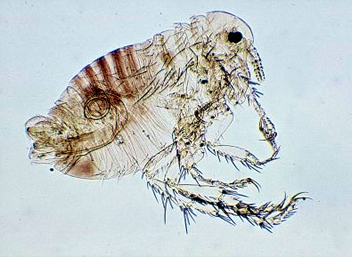

FLEAS (SIPHONAPTERA) OF BRITISH COLUMBIA

Human flea (Pulex irritans), female
by
R. A. Cannings and G. G. E. Scudder
Copyright © 2007 - All rights reserved
Introduction
Fleas are small wingless insects, as adults, laterally flattened, blood-sucking and capable of jumping. The body has numerous setae, is shiny and yellowish brown to black in colour. The head has short antennae that lie in deep grooves, and can be raised and used for grasping the female during mating. The mouthparts are adapted for piercing and sucking and consist of three elongated, sharp piercing elements. Eyes may be present or absent, but ocelli are always absent. Genal and or thoracic combs may be present or absent. The legs are rather long and stout, adapted for clinging with large coxae, and long 5-segmented tarsi. The hind legs are especially important for jumping.
Segment X on the abdomen in both sexes bears a dorsal sensillum, which is rather like a pincushion in appearance. Cerci are absent. The female may have one or two spermatheca, and the male genitalia are the most complex in the entire animal kingdom.
The life cycle consists of egg, larva pupa and adult, with the pupa in a cocoon. Eggs laid by the female fall free from the host, usually accumulating in the nest, den or home of the host. The larvae, which are rather elongate, whitish and rather maggot-like, lacking both eyes and legs, but normally rather setose, feed on the organic debris and faecal droppings of the parents that collect in dens, nests and the like. There are three larval instars. Pupation takes place in a cocoon, and the newly formed adults can remain for many months in this cocoon without food. Such pre-emergence adults are sensitive to both warmth and vibration, and can emerge quickly to infect the host or any other warm-blooded animal causing a disturbance. This phenomenon is well known to many cat-loving owners when they return to a cottage or home after a winter or vacation.
It is only the adult flea that sucks blood from warm-blooded vertebrates. Most fleas are host specific, or restricted to a particular family or Order of birds or mammals. In some species, the breeding cycle of the flea is very closely linked to that of the host. For example, it has been shown that the hormones that circulate within a pregnant rabbit also induce ovary maturation in rabbit fleas.
Most fleas regularly move from one host to another. They are capable of serving as vectors of a number of microorganisms. The best known disease transmitted by fleas is plague, and infectious disease caused by the bacillus Pasteurella pestis (Lehman and Neumann). Endemic typhus caused by a Rickettsia can also be spread to people from rats by fleas. Fleas can also serve as intermediate hosts of tapeworms, such as the tapeworm of dogs and cats.
Of the eight families of fleas known from North America, only seven occur in Canada and British Columbia. The family Rhopalopsyllidae is absent.
Note:
This write up is extracted from the forthcoming publication by Scudder and Cannings: the Insect Families of British Columbia.
Illustrations by L. L. Lucas. Copyright © 2005 - All rights reserved
Please cite this work as:
R. A. Cannings and G. G. E. Scudder. 2007. The Insect Families of British Columbia: The Siphonapatera of British Columbia. [Website] In: Klinkenberg, Brian (Editor). 2007. E-Fauna BC: Electronic Atlas of the Fauna of British Columbia. [www.efauna.bc.ca]. Lab for Advanced Spatial Analysis,Department of Geography, University of British Columbia, Vancouver.
© Copyright 2021 E-Fauna BC.